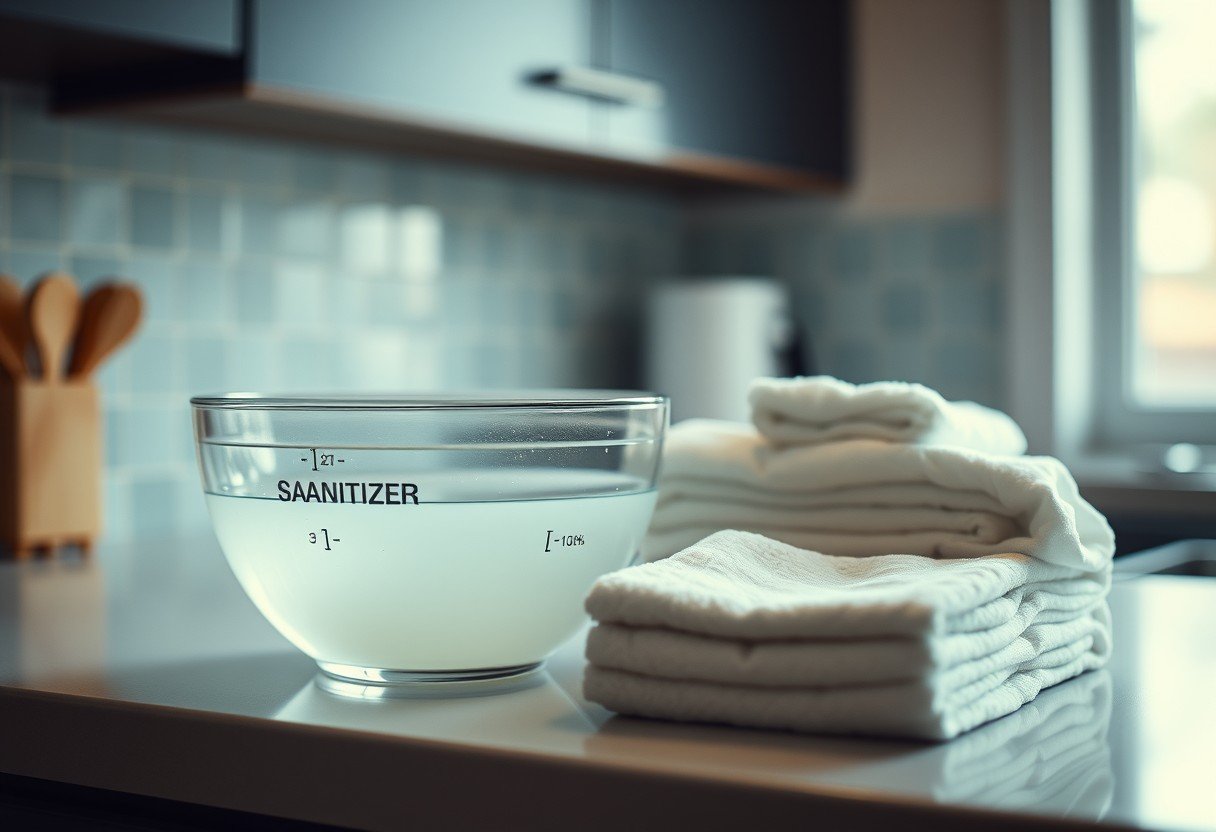Keeping kitchen surfaces clean is vital for food safety, and how you handle your cleaning towels plays a huge role. Storing towels used for food spills in a sanitizer solution is a highly effective practice recommended by health experts. This method helps kill harmful bacteria and prevents germs from spreading. This guide explains the correct way to do it, the best solutions to use, and how to maintain a truly hygienic kitchen environment.
Why Storing Towels in Sanitizer is a Smart Habit
Leaving a damp, used towel on the counter creates a perfect breeding ground for bacteria. When you reuse that towel, you can spread germs like E. coli or Salmonella to other surfaces, a process known as cross-contamination. This poses a significant risk to your health.
Storing your cleaning cloths in a sanitizer solution between uses actively kills these dangerous pathogens. This simple step ensures that whenever you grab a towel to wipe a spill, you are cleaning the surface, not adding more germs to it. It’s a proactive measure that elevates your kitchen’s hygiene standards significantly.
This practice is not just for commercial kitchens; it’s a valuable technique for any home. It provides peace of mind, knowing your cleaning tools are not contributing to the spread of foodborne illnesses. It’s a convenient and cost-effective way to keep your family safe.
Choosing the Right Sanitizer for Your Kitchen Towels
Not all sanitizers are the same. For kitchen use, you need a solution that is approved for food-contact surfaces. The most common and effective options are readily available and easy to prepare.
The key to any sanitizer is using it at the correct concentration. If the solution is too weak, it won’t kill germs effectively. If it’s too strong, it can damage your towels and leave behind harmful chemical residues. Always follow the manufacturer’s instructions for dilution carefully.
Here are some common types of sanitizers suitable for kitchen towels:
| Sanitizer Type | Common Active Ingredient | Typical Concentration |
|---|---|---|
| Chlorine Bleach | Sodium Hypochlorite | 200-300 ppm |
| Quaternary Ammonium (Quats) | Alkyl Dimethyl Benzyl Ammonium Chloride | 150-400 ppm |
| Iodophors | Iodine | 12.5-25 ppm |
Using test strips is a great way to check if your sanitizer solution is at the proper strength. This ensures you are getting the maximum microbial benefit without the risks of an incorrect mixture.
The Correct Steps to Sanitize and Store Towels
Simply tossing a dirty towel into a bucket of sanitizer isn’t enough. To do it correctly, you must follow a process that ensures the towel is truly clean and the sanitizer can work effectively. Following these steps will help you maintain the highest level of hygiene.
The first step is arguably the most important, as sanitizer is not a cleaner. It is designed to kill germs on an already clean surface. Food particles and grease can neutralize the sanitizer, making it useless.
Here is the proper procedure to follow:
- Wash First: Before sanitizing, you must wash the towel with soap and hot water to remove all food debris, grease, and dirt. Rinse it thoroughly.
- Prepare the Solution: Mix your chosen sanitizer with water according to the product’s label in a clean, dedicated container. A bucket with a lid works perfectly.
- Submerge Completely: Place the clean, rinsed towel into the sanitizer solution, making sure it is fully submerged.
- Store Safely: Keep the container covered to prevent contaminants from getting in and to stop the solution from evaporating. Store it conveniently but away from food preparation areas.
- Change Regularly: You should replace the sanitizer solution every 2-4 hours or whenever it becomes cloudy or dirty. A fresh solution is an effective solution.
This routine ensures your towels are always ready for use and are a tool for cleanliness, not contamination.
Potential Downsides and How to Avoid Them
While storing towels in sanitizer is beneficial, there are a few potential drawbacks to be aware of. Understanding these issues can help you manage them effectively so you can continue the practice safely. The main concerns are the long-term effects on the towel fabric and the potential for chemical residue.
Continuous exposure to chemicals, especially bleach, can weaken the fibers of your towels over time. This can cause them to become thin, lose absorbency, and wear out faster. However, this is often a small price to pay for the significant improvement in food safety.
Here’s a quick look at the pros and cons:
| Pros | Cons |
|---|---|
| Reduces bacteria and germs | May weaken fabric fibers over time |
| Prevents cross-contamination | Can leave chemical residue if not rinsed |
| Enhances overall kitchen hygiene | Requires regular changing of the solution |
To minimize damage, you can rinse the towels with clean water before use, especially if you are wiping down a surface that will directly contact food. Also, rotating your towels and replacing them when they show signs of wear ensures you always have effective cleaning tools on hand.
Alternatives to Soaking Towels in Sanitizer
If you prefer not to keep a bucket of sanitizer solution in your kitchen, there are other excellent methods to ensure your cleaning cloths remain hygienic. These alternatives rely on diligent cloth management and different cleaning agents to prevent bacterial growth and cross-contamination.
One of the most effective strategies is simply to use a fresh towel for each cleaning task and launder them frequently. Washing towels in hot water with detergent and bleach (for white towels) at the end of each day is a highly effective way to kill pathogens.
Consider these cloth management strategies:
- Color-Coding System: Designate different colored cloths for different tasks. For example, use blue cloths for cleaning surfaces, red for raw meat spills, and green for vegetables. This simple system drastically reduces the risk of cross-contamination.
- Use Hot Water and Soap: For many daily spills, a thorough cleaning with hot, soapy water is sufficient. This physically removes germs from surfaces.
- Vinegar or Hydrogen Peroxide Solutions: For a more natural approach, you can use solutions made with white vinegar or hydrogen peroxide. While not as powerful as commercial sanitizers, they offer mild disinfecting properties for low-risk cleaning tasks.
The key to any alternative method is consistency. A strict routine of washing, drying completely, and properly storing your cleaning cloths is essential to maintaining a safe kitchen.
Common Mistakes to Avoid with Sanitizer Use
Many people believe that sanitizer is a magic solution that cleans and disinfects simultaneously, but this is a dangerous misconception. For sanitizers to work, the surface must already be clean. Sanitizer is meant to kill microscopic germs, not remove visible dirt and grime.
Applying sanitizer to a dirty surface is ineffective because the food particles and dirt shield the bacteria from the chemical. This means you are wasting the product and leaving harmful pathogens behind. Always remember the two-step process: clean first, then sanitize.
Another common mistake is not allowing for proper contact time. Sanitizers don’t work instantly. Most require the surface to remain wet with the solution for a specific period, often ranging from 30 seconds to several minutes, to effectively kill germs. Check the product label for the required contact time and ensure you follow it.
Frequently Asked Questions about Sanitizing Kitchen Towels
How often should I change the sanitizer solution for my towels?
You should change the solution at least every 2 to 4 hours. If it becomes visibly dirty, cloudy, or filled with food debris before that, you should change it immediately to maintain its effectiveness.
Can I use regular bleach to sanitize kitchen towels?
Yes, a diluted household bleach solution is an effective and approved sanitizer for food-contact surfaces. A common ratio is one tablespoon of bleach per gallon of cool water, but you should check the bleach label for exact instructions.
Will storing towels in sanitizer ruin them over time?
Continuous exposure to chemicals can cause towel fibers to break down faster, reducing their absorbency and lifespan. You can mitigate this by rinsing towels before use and replacing them when they appear worn out.
Is it necessary to wash towels before putting them in sanitizer?
Absolutely. Sanitizers are not cleaners. You must wash towels with soap and water first to remove dirt and food particles, which can prevent the sanitizer from working properly.
What’s the difference between cleaning and sanitizing?
Cleaning uses soap and water to remove physical dirt, grime, and some germs from a surface. Sanitizing uses chemicals to kill the vast majority of remaining germs and bacteria to reduce them to a safe level.
Are there signs my cleaning towel is no longer safe to use?
Yes, if a towel has a persistent unpleasant odor even after washing, visible mold spots, or has become thin and non-absorbent, it’s time to replace it. These are signs that it may be harboring bacteria.







Leave a Comment